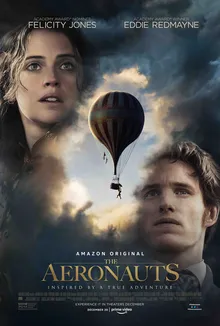Historical accuracy of The Aeronauts

Historical accuracy of The Aeronauts

Characters
James Glaisher
Based on the real James Glaisher (1809–1903), a pioneering meteorologist and astronomer who made numerous balloon ascents for scientific purposes in the 1860s. The film captures his scientific drive but simplifies his career and relationships.
Amelia Wren
Amelia Wren is a fictional character created for the film. She replaces Glaisher's actual co-pilot on the record-breaking 1862 flight, Henry Tracey Coxwell. Wren is inspired by real female aeronauts like Sophie Blanchard and Margaret Graham.
John Trew
Likely a composite or fictional character representing Glaisher's scientific peers or assistants who supported his work, providing exposition and grounding his earthbound struggles. Played by Himesh Patel.
Arthur Glaisher
Depicted with dementia (played by Tom Courtenay), this character adds personal drama but his specific portrayal and condition are likely fictional elements for the narrative.
Antonia
As Amelia Wren is fictional, her sister, who expresses concern about Amelia's risky profession, is also fictional, serving to develop Amelia's backstory. Played by Phoebe Fox.
Pierre Rennes
A fictional character created as part of Amelia Wren's backstory, providing motivation (grief, trauma) for her initial reluctance to fly again. His death mirrors aspects of Sophie Blanchard's husband's fate.
More characters
Henry Tracey Coxwell
The experienced aeronaut who actually accompanied Glaisher on the famous 1862 flight and saved them when Glaisher passed out. His crucial role is entirely given to the fictional Amelia Wren in the movie.
Story
Glaisher seeks funding for weather prediction research
James Glaisher was a real scientist who believed balloon ascents could advance meteorology and sought support for his expeditions from bodies like the British Association for the Advancement of Science.
Glaisher partners with Amelia Wren
Glaisher's partner on the famous September 5, 1862, flight was the male aeronaut Henry Tracey Coxwell, not the fictional Amelia Wren.
Spectacle of the balloon launch
Public balloon launches were major spectacles in the 19th century, attracting large crowds, similar to the festive atmosphere depicted at the film's start. Wren's showmanship is inspired by figures like Sophie Blanchard.
Scientific observations during ascent
Glaisher did take scientific instruments (thermometers, barometers, hygrometers) aloft to measure temperature, pressure, and humidity at different altitudes, as shown in the film.
Encountering and flying through a storm
While balloonists certainly faced dangerous weather, the dramatic storm sequence depicted is likely a composite or exaggeration based on the general perils of flight, not a specific event from the 1862 record flight.
Reaching record-breaking altitude
Glaisher and Coxwell did break the world altitude record on September 5, 1862, likely reaching between 35,000 and 37,000 feet, though exact measurements were lost due to hypoxia.
Glaisher suffering hypoxia / passing out
Glaisher accurately recorded passing out due to lack of oxygen at extreme altitude (around 29,000 feet).
Wren climbs exterior of balloon to release frozen valve
This dramatic climax is fictional. In reality, Coxwell (not Wren) saved them. With his hands frostbitten and unusable, Coxwell climbed the rigging and pulled the valve cord with his teeth to initiate descent.
Use of pigeons for communication/observation
Glaisher did take pigeons on his flights, partly to observe their reaction to altitude and potentially as messengers, though their effectiveness was limited. The pigeon dying from lack of oxygen reflects a real observation.
Wren's backstory (husband's death, trauma)
This entire subplot is fictional, created for the character of Amelia Wren, though drawing inspiration from the life of Sophie Blanchard, whose husband also died following a ballooning incident.
Glaisher facing skepticism from scientific community
While Glaisher was established, predicting weather was in its infancy, and pushing boundaries often meets skepticism. The film may exaggerate the hostility for dramatic effect. The British Association did support his actual 1862 flights.
Single flight combines multiple events
The film condenses experiences and potential dangers from several of Glaisher's 28 real ascents (and possibly other balloonists' experiences) into one dramatic flight for narrative purposes.
Setting
Victorian London / England (1862)
The film effectively recreates the visual aesthetic of mid-Victorian England, including cityscapes, interiors, and the societal atmosphere surrounding scientific endeavors and public spectacles.
Scientific community portrayal
Captures the formal setting of scientific societies (like the Royal Society mentioned, though Glaisher presented to the British Association) but may dramatize the level of unified opposition to Glaisher.
Gas balloon design and operation
The large coal gas balloon ('Mammoth' was Coxwell's real balloon name), basket, rigging, and basic principles of operation (using ballast and gas valve) are generally accurately represented for the era.
Balloon launch event atmosphere
Recreates the carnival-like atmosphere and large crowds associated with 19th-century balloon ascents, which were popular public entertainment events.
Scientific instruments of the period
Shows instruments like thermometers, barometers, and hygrometers consistent with what Glaisher would have used for his atmospheric measurements.
Costumes (Victorian attire / flight gear)
Ground-based costumes reflect typical mid-Victorian fashion. The flight attire, while perhaps slightly stylized for Amelia, considers the need for warmth at altitude, aligning with historical practices.
Depiction of high-altitude environment/weather
Visually represents the beauty and extreme danger of high altitudes – intense cold, thinning oxygen, cloudscapes, storms – creating a convincing sense of place for the main action.
